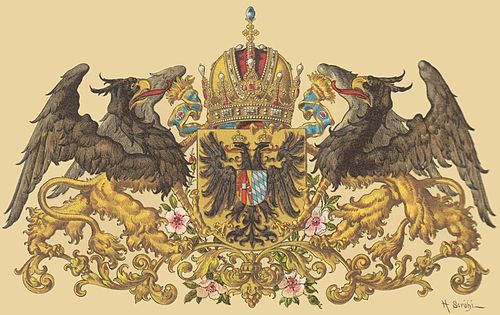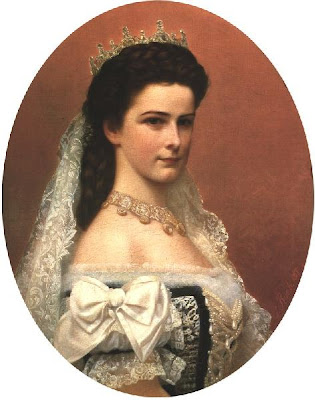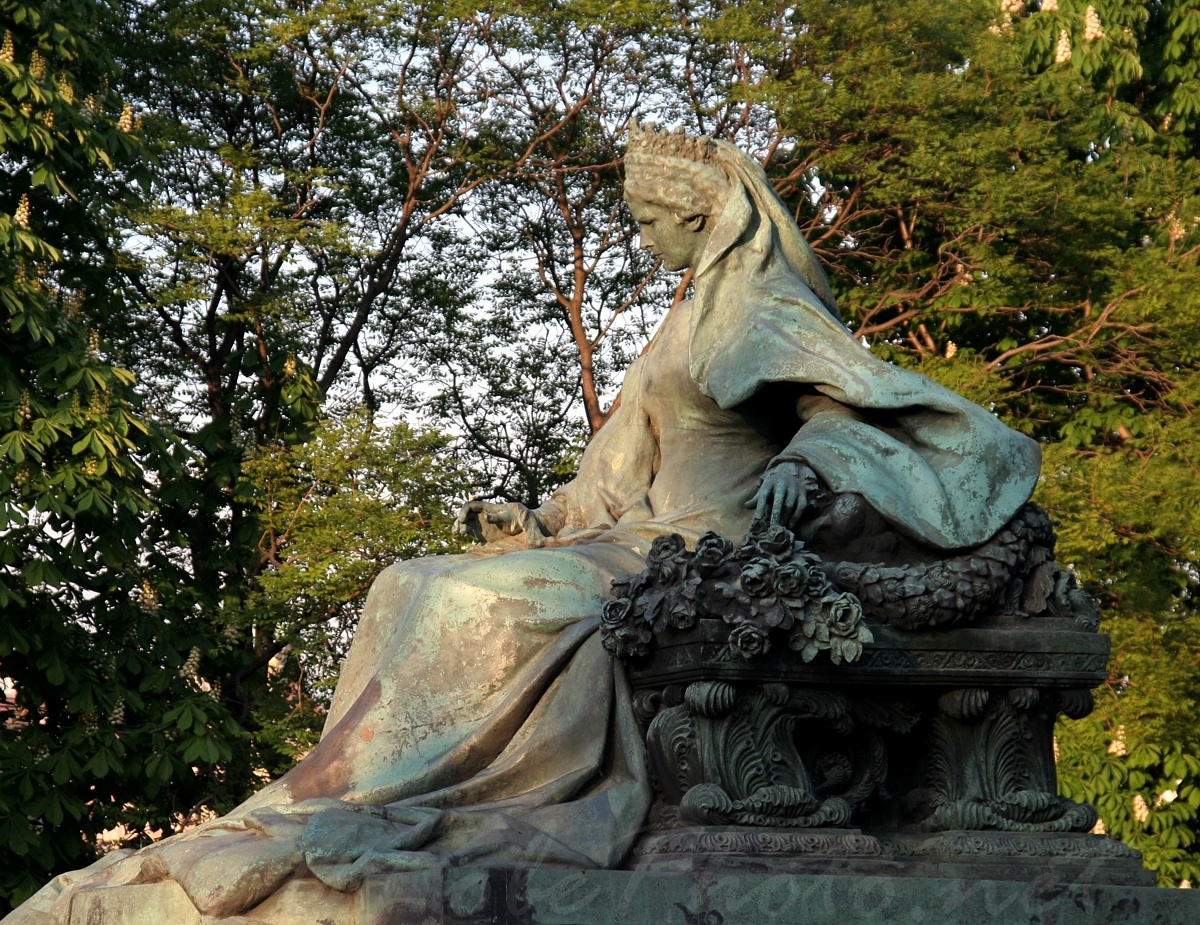
The box on one of the busiest areas of the space can be found. To his approach, his preemption, hiding very big circumspection and attention necessary in all times of day. Please make sure to close it correctly and return it exactly as found!!! The cache contains only a log so you will have to bring your own pen... Good luck!
ELIZABETH, Empress of Austria and Queen of Hungary
1837–98, empress of Austria and queen of Hungary. A Bavarian princess, she was married (1854) to her cousin, Emperor Francis Joseph I. Despite her exceptional beauty, intelligence, and kindness she led an unhappy domestic life, which was marred, moreover, by family tragedies (notably the death of her only son, Archduke Rudolf, and the death of one of her sisters in the charity bazaar fire in Paris, 1897). Independent and unconventional, she avoided the stiff etiquette of the Viennese court and spent much of her time abroad, chiefly on Corfu. She was assassinated by the Italian anarchist Luccheni in Geneva, Switzerland.

Elisabeth of Bavaria (24 December 1837 – 10 September 1898) was Empress of Austria and Queen of Hungary and Bohemia as spouse of Francis Joseph I. From an early age, she was called “Sisi” or "Sissi" by family and friends. While Elisabeth’s role and influence on Austro-Hungarian politics should not be overestimated (she is only marginally mentioned in scholarly books on Austrian history), she has undoubtedly become an historical icon. Elisabeth was considered to have been a free spirit who abhorred conventional court protocol; she has inspired filmmakers and theatrical producers alike.



Elisabeth Empress of Austria- Queen of Hungary
In 1998 the world remembered a fascinating woman: „Sisi“ the Empress of Austria. One hundred years ago, on September 10th, 1898, Sisi died after she was murdered by an anarchist.
Elisabeth was born on Christmas 1837 in Munich.
Her father was Duke Maximilian and her mother was Maria Ludowika.
She lived in the castle Possenhofen and there she became a sensitive person.
In summer 1853 she met the Emperor Franz Joseph of Austria. The Emperor had to marry her sister Helene. But he loved Elisabeth and not Helene. Her mother found this was not good. With Franz Joseph Sisi became a rising star. The „paparazzi“ and court painters produced pictures of this beautiful young duchess they called „Sisi“. Franz and Sisi married on the 24th April, 1854 in the Augustine Church in Vienna. In 1855 Sisi gave birth to Sophie, her first daughter. In the following year came Gisela. Then finally at last, in 1858 came crown-prince Rudolph. He was long awaited.
In the eyes of the public, Sisi soon became a fairy-tale princess with her charm and natural grace. But in her private life the problems began. In Madeira and Corfu she spent a lot of time trying to escape the hard life at court. In Vienna she was unhappy and during the early years of her marriage, Elisabeth took refuge in isolation, and illness. During the time in Madeira and Corfu she had to leave her children in the hands of her mother-in-law. The official public explanation was „severe illness“. After the birth of the crownprince, Sisi was not entrusted with his education. So she broke into open rebellion. In 1859, Elisabeth left her husband and her children to live in Madeira, Corfu and Venice, but she came back.
The Empress had exchanged an untroubled country and hardly adapt to it. Franz Joseph loved his wife, but he ruled over an empire of 50 million people and had little time to be with Sisi, who felt lonely. Sisi wished, her husband was no emperor. She said this to her former governess.Then a fourth child was born, Maria Valerie. Maria Valerie got the name “Hungarian child“ because she was educated in the Hungarian language. The new baby arrived exactly ten months after the cororation of her husband as King of Hungary, which Elisabeth had been so energetic in promoting. In this time, Elisabeth was more in Budapest than in Vienna and she learned to speak Hungarian fluently, much to the anger and displeasure of her mother-in-law. In 1860 Elisabeth was the world’s most beautiful monarch. In the 1870s she became the most famous and probably also the world’s best female.
Personal blows left heavy marks on the life of the Austrian empress. She lost her daughter, Sophie in 1857, and her favorite cousin, King Ludwig II of Bavaria in a tragic way. Her brother-in-law, Emperor Maximilian of Mexico, was murdered by the revolutionaries. She could never believe the suicide of her son Rudolph in 1889. In her pain, she travelled to Greece and Italy. She undertook lengthy and strenuous hikes. She had depressions that led finally to suicidal fantasies. On September 10, 1898 she left a hotel in Geneva and went on board of a steamboat for Montreux. Before she went on board, she was stabbed by an anarchist. At first Sisi didn’t notice the injury, but when she was on board she broke down and she was brought to the hospital, where she died.
The sorrows of Sisi are comparable with the sorrows of Princess Diana.Thousands of people accompanied the funeral and the people still bring today flowers to her grave.
Sisi was and still is a fascinating woman and her fate was cruel. All people had to think about her and she was a moved woman. She was a famous woman and she was very strong, because she had put herself against her mother-in-law and the men at court. She was a wonderful woman!
Statue of Queen Elisabeth made by György Zala in 1932. It was standing at March 15th square from 1932 to 1947, from that time it was in storage till 1986. Queen Elisabeth nicknamed Sisi was the wife of Francis Joseph. She was considered to be the most beautiful woman at that time. She is still one of the most popular historical person in Hungary because of her personality. Hungarians don't forget that she supported them and had a major role in turning the absolutist Austrian regime into the flourishing Austro-Hungarian Monarchy.
Sissi in the arts, literature, drama, dance and music:
Sissi (1955, film); Sissi — The Young Empress (1956, film); Sissi — Fateful Years of an Empress (1957, film); Mayerling (1968, film); The Phantom of the Opera (2004, film); Sissi Impératice (1984, balett); Elisabeth (1992, musicals); Spangle (1987, novel); Erzsébet híd, Erzsébet Bridge or Elisabeth Bridge in Budapest (1903); Erzsébet bridge in Komárom (1892); ect... Named after Budapest's highest point, János Hill of the lookout tower.
Approach:
Bus: 86, 5, 178-178/A, 956.
Trams: 19, 41, 18
The nearby pay parking available.





Good luck, and enjoy the cache! Happy caching!
Paleo.team
version 1.0.0

Click To Rate This Cache